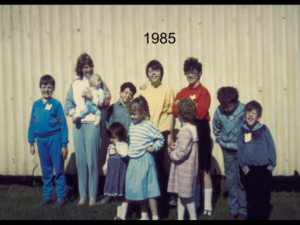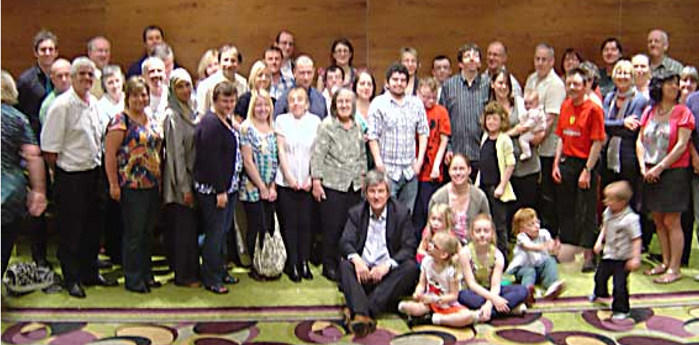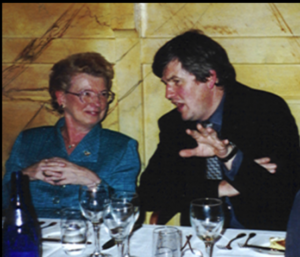


I became involved with Noonan syndrome almost by accident but now I have completed almost 30 years of research into the condition and helped to discover the main gene responsible for Noonan syndrome.
The first meeting of families with Noonan Syndrome was organised by Sheila Brown in 1986. She decided to invite a doctor to speak to the families and asked my consultant at Great Ormand Street Dr Michael Baraitser to talk. Dr Baraitser looked in his diary and saw the invitation to speak was on the August Bank Holiday. He therefore decided it was more appropriate from his senior registrar! He asked me to talk at the first families meeting and as I was not planning to go away, I agreed. We had had a lot of bank holidays which were washed out by rain. However, on this occasion it turned out to be scorching hot and my family went off to the beach without me. Instead I made my way to a church hall in Harrow with some regrets about having committed to give this lecture, but I received a very warm welcome and knew my efforts were much appreciated.
Although the syndrome had been described by a paediatric cardiologist Dr Jacqueline Noonan in 1963 not much was known about the syndrome outside the cardiac features she had described. With Sheila we did the first questionnaire for the families and started to define the other clinical features.
I moved to take up a Consultant appointment at St Georges that summer, but it meant starting the department from scratch. I literally had to find a desk and chair to sit on but slowly over the years build up the genetic services for the 3 million people living in South West London, Surrey and West Sussex. It was quite a challenge.
One of my first patients was James Lewis who had Noonan syndrome and whose father Leonard was running Chelsea Girl which his now known as River Island. I helped as far as I could but also arranged for the family to see Jackie Noonan in the States. Leonard realized there was a need for research and asked me to make a research proposal for him and his family to consider. I proposed having a clinical research fellow to examine all the UK families to define the clinical features and to find the gene.
The response to my proposal was to invite me for dinner in a private dining room in Park Lane. I remember being grilled about the proposal and by the end of the evening I thought to myself that I may not get the research funding but had at least had an excellent meal with which to remember the occasion. To my surprise I received a phone call the following day not only agreeing to the research proposal but also suggesting funding a part time nurse to help and making the proposal for 3 years instead of 2 years. This start up funding was invaluable and with it we were able to continue the work long term with help from other charities including the British Heart Foundation and the Birth Defects Foundation.
That was how the research started. I appointed Dr Mike Sharland as the first clinical research fellow. We contacted all the paediatricians and geneticists in the UK to identify the families with Noonan syndrome and over the next 2 years brought them up to St Georges for a day where we did heart scans and blood samples as well as documenting all the clinical features. There were around 120 families and so the clinical data built up quickly. There were many new discoveries. We learnt about the feeding difficulties and some of the clotting problems. We learnt how the facial features changed with age. We learnt about the natural history of the cardiomyopathy with the help of another clinical research fellow Dr Mike Burch.
By the end of the 3 years we had published around 15 clinical papers and both Mike Sharland and Mike Burch had successfully completed their MD theses in aspects of Noonan syndrome (and both are now Professors of Paediatrics)
I first meet Jackie Noonan when we started looking for the gene and she gave me a signed copy of her original 1963 paper on the syndrome with the signed inscription – “Dear Michael, I hope you find the gene soon – Jackie”. Since then we meet several times and she has continued to take an interest in both the research and the families.
Nowadays with routine gene sequencing it is difficult to explain what the challenge of finding the gene for Noonan Syndrome was. At the time I started there were only about 20 disease genes discovered so it was like knowing you were looking for an undiscovered town with a world map with the continents in place and only 20 towns on the whole map of the world. The problem was where to start looking for the undiscovered town without knowing which country or continent it was on. The solution was to start looking to see if it was close to any of the known towns and if it was you would know where it fitted on the map. In genetic terms we knew Noonan Syndrome was inherited in families but didn’t know which of the 23 chromosomes it might be on. We tested each known genetic marker to see if the genetic marker ran with Noonan Syndrome in the families we had. We knew that eventually we would strike lucky by finding a genetic marker which was running with Noonan syndrome and this by implication would tell us roughly where the gene was located.
We knew there were some similarities with Neurofibromatosis and early on were able to exclude this as the gene for Noonan syndrome but we soon realised we would need more families to map the gene. This led to a very fruitful collaboration with Ineke van den Berghe and her colleagues in Nijmegen in the Netherlands. We pooled the UK and Dutch samples and divided the work between us allocating different chromosomes to each group. We were fortunate that we had been allocated chromosome 12 and eventually with Ruth Jamieson and Steve Jefferies we found linkage between Noonan Syndrome and markers on the long arm of chromosome 12 (12q14).
With great excitement we wrote the finding up for one of the top journals – Nature Genetics. However, after a couple of months we had heard nothing and so with some trepidation rang the editorial office in New York to enquire about the progress of the paper. It turned out it hadn’t arrived in New York! Fortunately, after that they were able to fast track it to publication. In those days mapping a gene was very significant and it was rather like being an early explorer who discovered a new island and putting up a flag to show you had discovered it.
With the mapping of the gene I started to give talks at various academic meetings. I enjoyed this part of the work and made many friends internationally. Not all talks went well. One that sticks in my mind was a conference in Amritsar on the Indian border with Pakistan during a border dispute. The regional Governor had been assassinated the month before, but the conference went ahead with an armed guard for the overseas speakers and a heavy military presence including a fully armed tank outside the conference. When it came to my talk, there was a power cut 10 minutes into the talk and the audience and I had to sit in the dark for 20 minutes until power could be restored. Since we had nowhere to go with the curfew, I got to know the other speakers very well and a few have remained firm friends. Most of the talks may have been less memorable but they all helped to spread the interest and understanding of Noonan Syndrome to a wide audience.
The problem after mapping the location of the gene was to find the gene and see what it did. The obvious way was to start to narrow down the region on chromosome 12 where we knew the gene was and hope to find it that way. The problem was we didn’t know what sort of gene we were looking for. Some of us thought it was a gene for heart development and others thought it might be a gene that controlled gene expression. I remember at one of our meetings with our Dutch colleagues I produced an acetate overhead at the discussion showing that Noonan syndrome and Neurofibromatosis shared several features in common and I showed when you looked at the cellular pathways the common pathway was through the RAS-MAPK pathway. I still have the acetate but unfortunately, I didn’t convince my colleagues at the meeting! However, to be fair at the time we didn’t know much about the genes located in the RAS MAPK pathway and would have had difficulty taking it forward.
The next few years were very frustrating. We tested innumerable genes as there were mapped and tested different strategies but didn’t make progress. However, at this stage we also teamed up with a research group with Bruce Gelb and Marco Tartaglia at Mount Sinai Hospital in New York. This meant we had a larger pool of families to test, but it also led to the next breakthrough. Bruce had spotted a paper showing that aortic valve abnormalities in the mouse could be caused by the SHP2 gene. He realised the significance of this because in Noonan Syndrome there is a similar abnormality in the pulmonary valve and more importantly the human SHP2 gene was located to the critical area on chromosome 12 where we knew the gene for Noonan’s syndrome was located. We then tested this gene against the pooled samples we had and we able to confirm that the SHP2 gene or PTPN11 gene as it is now known was a cause of Noonan Syndrome in about half of all cases. This time the paper went to Nature Genetics and there was no hold up.
It had been 15 years since Leonard had funded the initial proposal to find the gene for Noonan Syndrome, so I was pleased to be able to ring him and tell him of the discovery. After telling him about it I confessed that when I made my original proposal, I have just started a new department with letterheading being printed in the previous week and at that stage I didn’t have a lab to start the research in. To my surprise he told me that he knew this as he had carried out his own due diligence before making the grant and what he was funding was the person not the lab. I was genuinely very flattered by this response and I was glad to have been able to repay the confidence he had had in me.
The discovery of the PTPN11 gene changed the direction of the Noonan research. I realised this at a workshop we had at Harvard. I found that half the researchers in the meeting were cancer scientists. The PTPN11 gene is in the RAS MAPK pathway and the cancer scientists already had a good understanding of this pathway and were developing new drugs to treat cancers affecting other genes in the pathway.
There was further work to do in finding other genes in Noonan syndrome and our larger group found the second gene SOS1. Soon there were groups all round the world involved in this and the next genes were found in Japan, Italy and Germany. Our group at St Georges focused on understanding the lymphoedema and found new genetic causes for lymphoedema.
The gene mapping in Noonan syndrome is more or less complete but there is more research to do on the RAS-MAPK pathway and to understand how it may be modified by new drugs. This requires more basic science and the input from the pharmaceutical industry. One of the interesting discoveries on the cancer side was that a RAS gene BRAF is a key gene causing the most serious form of skin cancer – malignant melanoma. It was found that by blocking it with an experimental drug the widespread secondary tumours from a malignant melanoma could in some patients literally disappear in a couple of weeks. I hope that in the next 5-10 years we will see dramatic results from these new medications in some of the most serious aspects of Noonan syndrome such as cardiomyopathy or lymphoedema.
One of the proudest moments for me was asking the families at the NSA day how many had had a gene test and seeing over 100 hands going up. It is wonderful to see the gene discovery in the lab being used so widely in clinical practice. The gene test for PTPN11 is now used to test children with short stature and congenital heart disease throughout the world and it is estimated that more than 50,000 children around the world have this test each year. It has been quite an achievement and going back to the beginning of my story the moral is if someone asks you to give a lecture on a Bank Holiday, accept the invitation as you never know where it may lead in the end.
Professor Michael A. Patton